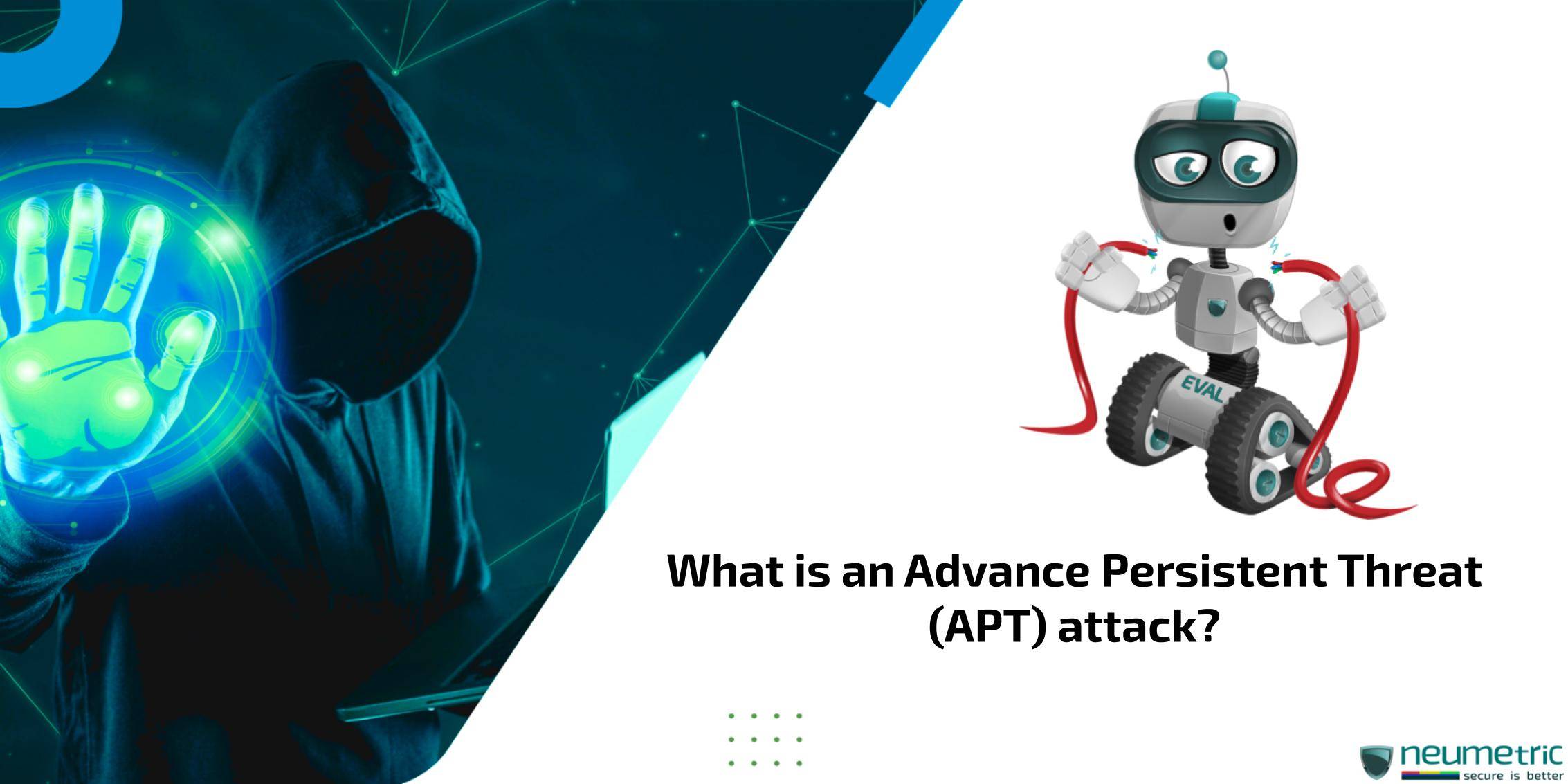Table of Contents
ToggleWhat is an Advanced Persistent Threat Attack [APT attack]?
Introduction
As we delve into the intricate world of APTs, it’s crucial to understand that these threats are often orchestrated by well-funded & highly skilled actors, ranging from nation-states to organized cybercriminal groups. Motivations behind APTs vary widely, from intelligence gathering & political espionage to economic sabotage. Throughout their lifecycle, APTs employ a combination of advanced techniques, including zero-day exploits, social engineering & persistent infiltration, making them formidable adversaries.
Detection of APTs requires a proactive & multi-layered approach, involving continuous monitoring, threat intelligence & collaboration between security professionals. Looking ahead, the evolution of technology is likely to fuel new avenues for APTs, emphasizing the need for adaptive cybersecurity measures to stay one step ahead in this ever-evolving digital battlefield.
Characteristics of APT Attacks
Stealth & Persistence
In the realm of cybersecurity, APT attacks stand out for their cloak-&-dagger approach. These threats are not the hit-&-run type; they’re in it for the long haul. The stealthy nature of APT attacks allows them to remain undetected for extended periods, enabling threat actors to meticulously plan & execute their malicious objectives.
Think of APTs as digital ninjas, expertly evading conventional security measures. Their persistence is a key factor, allowing them to maintain a foothold in compromised systems for weeks, months or even years. This prolonged engagement provides attackers with the time needed to carefully study the target environment & extract valuable information without triggering alarms.
Advanced Tactics, Techniques & Procedures [TTPs]
What sets APT attacks apart is their reliance on advanced tactics, techniques & procedures. It’s not just about using off-the-shelf malware; APT actors employ sophisticated methods that often go beyond the capabilities of standard cyber threats. These tactics include leveraging zero-day exploits, crafting custom malware & employing encryption to conceal their activities.
To grasp the complexity of APT TTPs, consider the analogy of a master chess player. APT actors strategically maneuver through the digital chessboard, making calculated moves to achieve their goals. These moves include social engineering, spear-phishing & exploiting vulnerabilities unique to the target’s environment. Understanding these advanced techniques is crucial for building effective defenses against APT attacks.
Anatomy of an APT Attack
Initial Compromise
APT attacks typically commence with a meticulously planned initial compromise. Threat actors use a variety of methods, including spear-phishing emails, watering hole attacks or exploiting unpatched vulnerabilities, to gain the initial foothold. The success of this phase often hinges on the exploitation of human vulnerabilities, making it essential to educate users about the dangers of social engineering.
Real-world examples showcase the ingenuity of APT actors during the initial compromise. Take the infamous Stuxnet worm, which exploited zero-day vulnerabilities to infiltrate Iran’s nuclear facilities. This incident exemplifies the precision & resourcefulness inherent in APT attacks.
Establishing Persistence
Once inside the target network, APT actors focus on establishing persistence, ensuring their continued presence. This involves creating backdoors, planting rootkits or manipulating legitimate system components to maintain access without arousing suspicion.
Think of APT persistence as a silent infiltrator weaving their way through a crowded room, leaving no trace of their passage. This stage is critical for the longevity of the attack, enabling threat actors to adapt to evolving security measures & maintain control over the compromised environment.
Lateral Movement
Lateral movement is the phase where APT actors explore the target network, expanding their reach & searching for high-value assets. Much like a skilled cat burglar navigating a maze of laser beams, threat actors employ techniques like privilege escalation, credential theft & lateral pivoting to move undetected within the network.
The goal is to identify & access sensitive information, gradually advancing towards the crown jewels of the target organization. APT actors move with precision, avoiding unnecessary noise that could tip off security teams.
Data Exfiltration
At the heart of every APT attack lies the objective to exfiltrate valuable data. Whether it’s intellectual property [IP], customer information or government secrets, threat actors employ various methods to discreetly siphon off data without triggering alarms.
Consider the 2017 Equifax breach, where APT actors exploited a vulnerability in the company’s web application to gain access to sensitive data of 147 million people. This incident underscores the real-world impact of APT data exfiltration, resulting in severe consequences for both the affected organization & the individuals involved.
Motivations Behind APT Attacks
Understanding the motivations behind APT attacks is crucial for predicting their behavior & developing effective defense strategies. APT actors fall into different categories based on their objectives, with state-sponsored, cybercriminal & industrial espionage being the primary motivations.
State-sponsored APTs
Nation-states engage in APT attacks for geopolitical reasons. These attacks serve as a means of intelligence gathering, political manipulation or even acts of cyber warfare. Notable examples include the alleged Russian interference in the 2016 U.S. presidential election & the Stuxnet attack, attributed to a joint effort by the United States [US] & Israel.
Cybercriminal APTs
While state-sponsored APTs focus on political or military objectives, cybercriminal APTs are primarily driven by financial gain. These attackers target organizations across various industries to steal sensitive financial information, trade secrets or any data that can be monetized.
Financially motivated APTs operate like high-stakes heists, with threat actors meticulously planning & executing attacks to maximize their illicit gains. The financial sector, in particular, remains a prime target for these APTs due to the potential for lucrative returns.
Industrial Espionage
In the competitive landscape of business & technology, APT attacks are frequently employed for industrial espionage. Competing companies or foreign entities seek to gain a strategic advantage by stealing intellectual property [IP], research & development data or trade secrets.
Imagine a scenario where a leading pharmaceutical company’s groundbreaking research is stolen by a rival through a well-executed APT attack. The consequences extend beyond financial losses to the broader impact on innovation, market competitiveness & in some cases, national security.
APT Attack Lifecycle
Understanding the lifecycle of an APT attack is akin to deciphering the playbook of a skilled adversary. Each stage in the APT lifecycle serves a specific purpose & threat actors meticulously execute their plan to achieve their ultimate objectives. The APT lifecycle typically comprises stages such as reconnaissance, initial compromise, persistence, lateral movement, privilege escalation, data exfiltration & finally, covering their tracks to maintain prolonged access & achieve their strategic goals.
Reconnaissance
The APT journey begins with reconnaissance, where threat actors gather intelligence on the target. This involves collecting information about the target’s infrastructure, employees & security measures. Open-source intelligence [OSINT] plays a crucial role in this phase, providing attackers with valuable insights that inform subsequent stages of the attack.
Imagine a scenario where a threat actor, armed with extensive knowledge gained through OSINT, identifies weak points in a target’s cybersecurity posture. This information serves as the foundation for the subsequent stages of the APT attack.
Weaponization
Armed with intelligence from the reconnaissance phase, threat actors proceed to weaponization, the stage where malicious tools are developed & deployed. This involves crafting sophisticated malware, exploiting zero-day vulnerabilities or repurposing existing tools to suit the attacker’s objectives.
Consider weaponization as the equivalent of forging a custom key to unlock a specific door. APT actors tailor their tools to bypass the unique defenses of the target, ensuring a higher likelihood of successful infiltration.
Delivery
With their virtual arsenal prepared, threat actors move on to the delivery phase. This is where social engineering comes into play, as attackers employ various tactics to deliver their malicious payloads to unsuspecting victims. Phishing emails, malicious attachments & compromised websites are common delivery mechanisms.
Conclusion
Advanced Persistent Threat [APT] attacks represent a sophisticated & persistent form of cyber threat orchestrated by well-funded & highly skilled actors, ranging from nation-states to organized cybercriminal groups. These attacks are characterized by their stealth, persistence & utilization of advanced tactics, techniques & procedures [TTPs]. APT attacks follow a lifecycle that includes stages such as reconnaissance, initial compromise, persistence, lateral movement, privilege escalation, data exfiltration & covering tracks.
The motivations behind APT attacks vary, encompassing state-sponsored objectives, financial gain for cybercriminals & industrial espionage. As technology evolves, the threat landscape for APTs is likely to expand, emphasizing the need for adaptive & multi-layered cybersecurity measures to effectively detect, prevent & respond to these formidable adversaries in the ever-evolving digital battlefield.
FAQ:
What makes APT attacks different from regular cyber threats?
Absolutely, APT attacks are like the James Bonds of the cyber world. Unlike your typical run-of-the-mill cyber threats that hit fast & loud, APTs are more like digital ninjas. They sneak in, stay for the long haul & operate with surgical precision. It’s not just about stealing data; it’s about staying undetected for as long as possible, making them a whole different ball game in the cybersecurity arena. In the realm of cyber threats, APTs stand out for their strategic intent & targeted focus. While regular threats may cast a wide net seeking immediate gains, APTs are akin to precision instruments, meticulously tailoring their attacks to specific targets. Their silent infiltration & prolonged presence make them formidable opponents, emphasizing the need for advanced defense strategies in the ever-evolving landscape of cybersecurity.
How do these cyber intruders manage to stay hidden for so long?
Think of APT actors as the ultimate hide-&-seek champions. They’ve mastered the art of stealth & persistence. Once they breach a system, they create backdoors, plant rootkits & essentially become the digital equivalent of a ghost, silently floating through the network without leaving a trace. It’s this ability to establish & maintain persistence that allows them to stay hidden for weeks, months or even years, studying the target environment & executing their malicious plans without setting off any alarms.
Why would someone go through the trouble of orchestrating an APT attack?
Well, it’s a bit like asking why someone would pull off an elaborate heist instead of just grabbing a purse & running. APTs are orchestrated for various reasons. Nation-states might engage in APTs for geopolitical leverage or even cyber warfare. On the flip side, cybercriminals are in it for the money, targeting organizations to steal valuable data that can be monetized. Then there’s the industrial espionage angle, where competitors or foreign entities aim to gain a strategic edge by pilfering intellectual property or trade secrets. It’s a high-stakes game with motivations as diverse as the attackers themselves.





